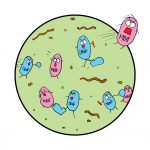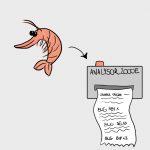Earlier programmes in the series Microbial Discoveries That Change Our Lives may be accessed here.
Single cell genomics and the built environment
 Microbiome Yarns: Microbiome of the built environment, paranormal microbiology, and the power of single cell genomics, 2018, by Kenneth Timmis, Franziska Jebok, Manfred Rohde and Gabriella Molinari. Microb. Biotech. 11: 575-587.
Microbiome Yarns: Microbiome of the built environment, paranormal microbiology, and the power of single cell genomics, 2018, by Kenneth Timmis, Franziska Jebok, Manfred Rohde and Gabriella Molinari. Microb. Biotech. 11: 575-587.
This Microbiome Yarn introduces the topics of humans 50% microbial, microbiology of the built environment, microbial forensics, single cell genomics, metabolic models, expression of silent genes, drug discovery, minimal genomes, auxotrophy and resource sharing in microbial communities, population heterogeneity, maintenance energy metabolism, gas vesicles, fluorescent proteins, melanin/microsporine-like amino acids and UV protection, ice nucleation protein and plant protection/albedo/artificial snow production, global inventory of microbial diversity, rarefaction, rare biosphere/biological dark matter, biological containment, mummy microbiomes (see also Krakova, L., Soltys, K., Puskarova, A., et al. 2018. The microbiomes of a XVIII century mummy from the castle of Krasna Horca (Slovakia) and its surrounding environment. Environm. Microbiol. 20, in press)
If you would like to know more, click here.
Bacterium:host interactions

Microbiome Yarns: human milk oligosaccharides, Bifidobacteriumand immunopowergames, 2018, by Kenneth Timmis and Franziska Jebok, Microb. Biotech. 11: 437-441.
This Microbiome Yarn introduces the topics of Bifidobacterium and human milk oligosaccharides, tight adherence and sortase-dependent pili, bacterium:host interactions steering immune development, genome minimisation and deletion of prophages.
If you would like to know more, click here.
Microbiome:host coevolution

Microbiome Yarns: human biome reproduction, evolution and visual acuity, 2017, by Kenneth Timmis, Franziska Jebok, Gabriella Molinari, Manfred Rohde and Leo Lahti. Microb. Biotech. 11: 149-159.
This Microbiome Yarn introduces the topics of microbial production of extracellular polymers, antibiotic resistance, microbial degradation of xenoestrogens and endocrine-disrupting chemical pollutants, Gaia, microbiome:host coevolution, Wolbachia and gender control of invertebrate host.
If you would like to know more, click here.
Microbiome-brain interactions and ultramicrobacteria
 Microbiome Yarns: microbiome basis of memory, 2017, by Kenneth Timmis, Franziska Jebok, Gabriella Molinari, Manfred Rohde and James Kenneth Timmis. Microb. Biotech. 10: 1283-1292.
Microbiome Yarns: microbiome basis of memory, 2017, by Kenneth Timmis, Franziska Jebok, Gabriella Molinari, Manfred Rohde and James Kenneth Timmis. Microb. Biotech. 10: 1283-1292.
This Microbiome Yarn introduces the topics of ultramicrobacteria, endosymbionts, origin of eukaryotic cells and organelles, biogenesis of nanoparticles, biomineralization, nanowires, gut-brain axis, neuro-micro-biology: microbiome-brain interactions that influence our behaviour, personalities, mental state and stress-related conditions like depression and autism, bioaugmentation and bioprotection, microbial memory.
If you would like to know more, click here.
Microbial forensics and heat stable toxins
 Microbiome Yarns: microbial forensics for auditing provenance in global food chains, 2017, by Kenneth Timmis, Franziska Jebok and Romilio T. Espejo. Microb. Biotech. 10: 678-682.
Microbiome Yarns: microbial forensics for auditing provenance in global food chains, 2017, by Kenneth Timmis, Franziska Jebok and Romilio T. Espejo. Microb. Biotech. 10: 678-682.
This Microbiome Yarn introduces the topics of pathogen ecology-environmental lifestyles, seafood-borne pathogens, Vibrio, toxigenic algae/red tides and neurotoxins, heat stable – cooking resistant toxins, use of antibiotics as prophylactic agents and growth promoters, aquaculture and antibiotic resistance, microbial signatures of food provenance/microbial forensics.
If you would like to know more, click here.
The rare biosphere and deep sequencing

Microbiome Yarns: microbiomology of winter rosy face, 2017, by Kenneth Timmis and Franziska Jebok. Microb. Biotech. 10: 520-524.
This Microbiome Yarn introduces the topics of the rare biosphere, deep sequencing, the viable but not culturable/persister/dormant state, small colony variants, tolerance of and resistance to host defences and antibiotics, relapsing infections, Yersinia/Pasteurella pestis and plague.
If you would like to know more, click here.
Curli fimbriae and protein expression

Microbiome Yarns: microbiomology of curly and straight hair, 2017, by Kenneth Timmis, Franziska Jebok, Fabio Rigat, Willem M. de Vos and James Kenneth Timmis. Microb. Biotech. 10: 231-237.
This Microbiome Yarn introduces the topics of curli fimbriae and their role in infections (adhesion to host cells, amyloid-like properties), temperature regulated protein expression.
If you would like to know more, click here.